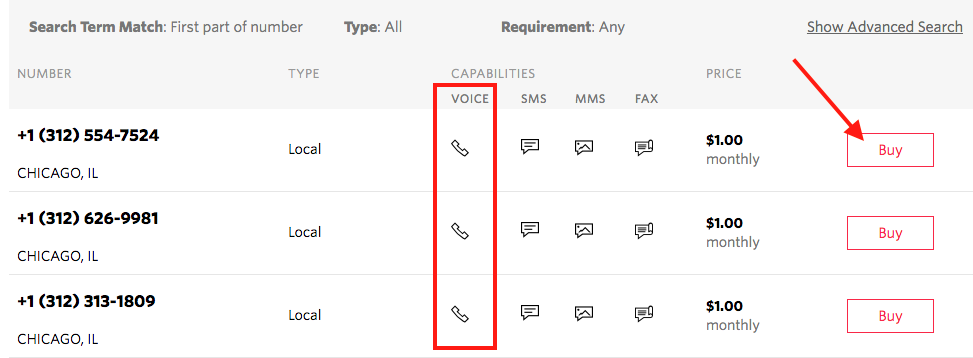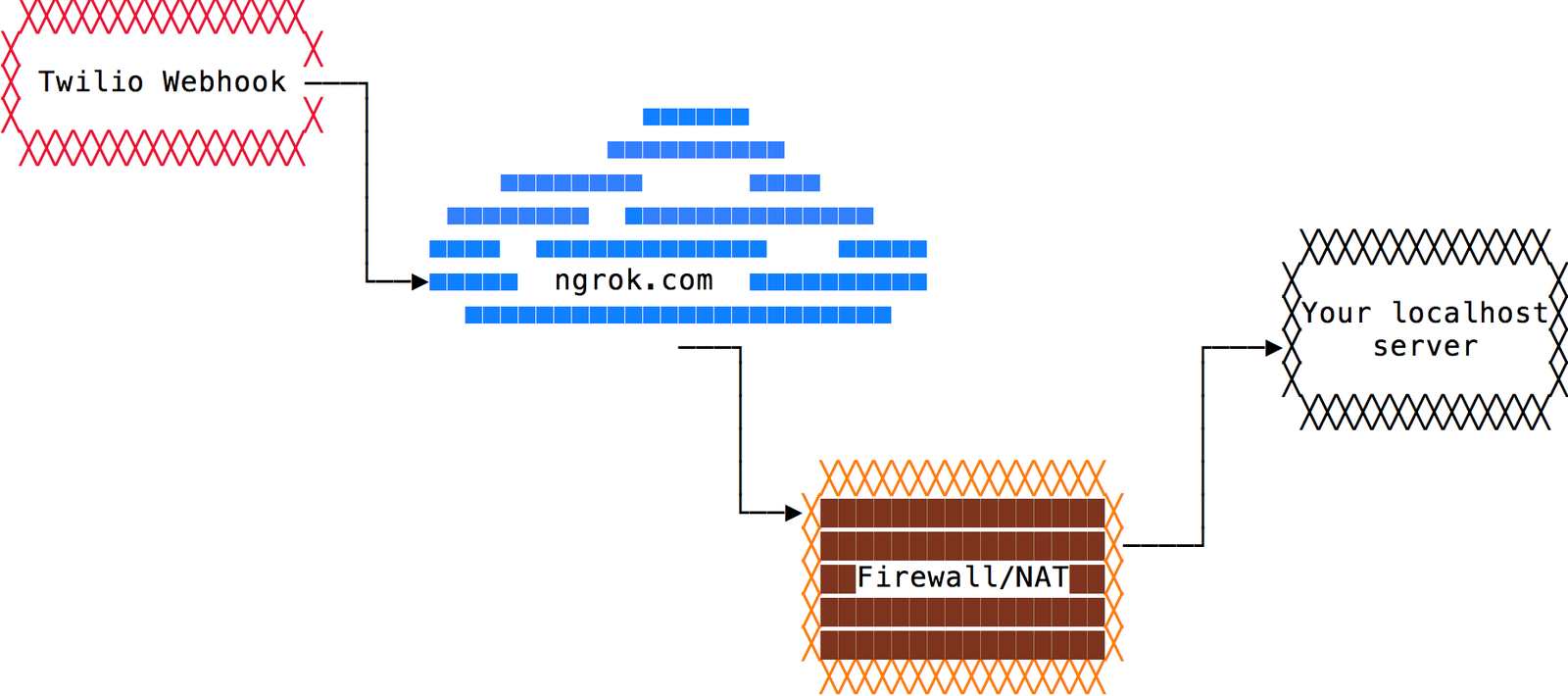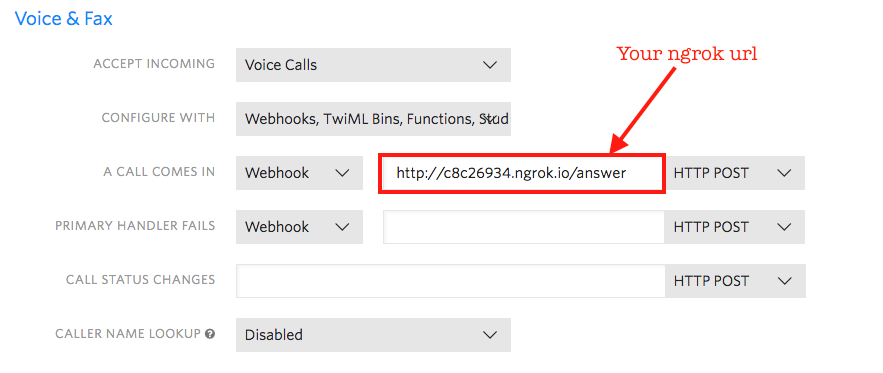Programmable Voice Quickstart for Python
With just a few lines of code, your Python application can make and receive phone calls with Twilio Programmable Voice.
This Python quickstart will teach you how to do this using our REST API, the Twilio Python helper library, and Python's Flask microframework to ease development.
In this quickstart, you will learn how to:
- Sign up for Twilio and get your first voice-enabled Twilio phone number
- Set up your development environment to make and receive phone calls
- Make an outbound phone call which plays an MP3
- Receive and respond to an inbound phone call which reads a message to the caller using Text to Speech
Prefer to get started by watching a video? Check out our video on how to place and receive phone calls with Python on YouTube.
Info
If you already have a Twilio account and a voice-enabled Twilio phone number you're all set here! Log in then feel free to jump to the next step.
Before you can make a phone call from Python, you'll need a Twilio account. Sign up here to get your free trial account or log in to an account you already have.
The next thing you'll need is a voice-capable Twilio phone number. If you don't currently own a Twilio phone number with voice call functionality, you'll need to purchase one. After navigating to the Buy a Number page, check the "Voice" box and click "Search."

You'll then see a list of available phone numbers and their capabilities. Find a number that suits your fancy and click "Buy" to add it to your account.

Now that you have a Twilio account and a programmable phone number, you have the basic tools you need to make a phone call.
You could use Twilio's HTTP API to make your phone calls, but we'll make things even more simple by using Twilio's official Python helper library. Let's install that next.
Info
If you've gone through one of our Python quickstarts already and have Python and the Twilio Python helper library installed, you can skip this step and get straight to making your first phone call.
To make your first phone call with Twilio, you'll need to have Python and the Twilio Python helper library installed.
If you're using a Mac or Linux machine, you probably already have Python installed. You can check this by opening up a terminal and running the following command:
_10python --version
You should see something like:
_10$ python --version_10Python 3.9 # Python 3.7+ is okay, too
Windows users can follow this excellent tutorial for installing Python on Windows.
Twilio's Python SDK only supports Python 3.7+.
The easiest way to install the library is using pip. Just run this in the terminal:
_10pip install twilio
If you get the error pip: command not found, you can use easy_install to install the Twilio helper library by running this in your terminal:
_10easy_install twilio
For a manual installation, you can download the source code (ZIP) for twilio-python and then install the library by running:
_10python setup.py install
in the folder containing the twilio-python library.
And with that, it's time to write some code.
Now that we have Python and twilio-python installed, we can make an outgoing phone call with a single API request from the Twilio phone number we just purchased. Create a new file called make_call.py and type or paste in this code sample.
This code starts a phone call between the two phone numbers that we pass as arguments. The 'from' number is our Twilio number, and the 'to' number is who we want to call.
The URL argument points to some TwiML, which tells Twilio what to do next when our recipient answers their phone. This TwiML tells Twilio to read a message using text to speech and then play an MP3.
Before this code will work, though, we need to edit it a little to work with your Twilio account.
Swap the placeholder values for account_sid and auth_token with your personal Twilio credentials.
Go to https://www.twilio.com/console and log in. On this page, you'll find your unique Account SID and Auth Token, which you'll need any time you send messages through the Twilio client like this. You can reveal your auth token by clicking on the eyeball icon:

Open make_call.py and replace the values for account_sid and auth_token with your unique values.
Danger
Please note: it's okay to hardcode your credentials when getting started, but you should use environment variables to keep them secret before deploying to production. Check out how to set environment variables for more information.
Remember that voice-enabled phone number you bought just a few minutes ago? Go ahead and replace the existing from_ number with that one, making sure to use E.164 formatting:
[+][country code][phone number including area code]
Next, replace the to phone number with your mobile phone number. This can be any phone number that can receive calls, but it's a good idea to test with your phone so that you can see the magic happen! As above, you should use E.164 formatting for this value.
Save your changes and run the script from your terminal:
_10python make_call.py
That's it! Your phone should ring with a call from your Twilio number, and you'll hear our short message for you. 😉
Warning
If you're using a Twilio trial account, outgoing phone calls are limited to phone numbers you have verified with Twilio. Phone numbers can be verified via your Twilio Console's Verified Caller IDs. For other trial account restrictions and limitations, check out our guide on how to work with your free Twilio trial account.
Next, we'll learn how to respond to a call made to your Twilio phone number. First, we'll need to get a Flask server up and running.
To handle incoming phone calls we'll need a lightweight web application to accept incoming HTTP requests from Twilio. We'll use Flask for this quickstart, but you can use your choice of web framework to make and receive phone calls from your applications.
For instructions on setting up Flask on Windows, check out this guide.
To install Flask and set up our development environment, we'll need two tools: pip to install Flask and virtualenv to create a unique sandbox for this project. If you already have these tools installed, you can skip to the next section.
Pip comes pre-packaged with Python 3.4+, so if you're on a recent version of Python, you don't need to install anything new. If you're on an earlier version, never fear: pip is included in virtualenv. So let's install virtualenv!
If you're using Python 2.4, run the following command in your terminal:
_10easy_install virtualenv
If you're using Python 2.5-2.7, run the following command in your terminal, specifying your version number:
_10easy_install-2.7 virtualenv
Replace the 2.7 with 2.5 or 2.6 if you have that version installed.
To install virtualenv with Python 3.4+:
_10# If you get 'permission denied' errors try running "sudo python" instead of "python"_10pip install virtualenv
If you get any errors in this step, check out these tips for debugging.
Once you have virtualenv installed, use your terminal to navigate to the directory you're using for this quickstart and create a virtual environment:
_10cd Documents/my_quickstart_folder_10virtualenv --no-site-packages .
Now, activate the virtual environment:
_10source bin/activate
You can verify that your virtualenv is running by looking at your terminal: you should see the name of your enclosing directory. It will look something like this:
_10(my_quickstart_folder)USER:~ user$
To learn more about virtualenv or create a custom environment path, see this thorough guide.
Now we're ready to install Flask. Create a file called requirements.txt and add the following lines to it:
_10Flask>=0.12_10twilio~=6.0.0
Then install both of these packages with pip in your terminal:
_10pip install -r requirements.txt
First, make sure your virtualenv is activated:
_10cd Documents/my_quickstart_folder_10source bin/activate # On Windows, use .\bin\activate.bat
Then, create and open a file called answer_phone.py and add these lines:
Test your setup with this simple 'Hello, World' Flask application.
Now it's time to try running it. In your terminal, type:
_10python answer_phone.py
You should see:
_10$ python answer_phone.py_10* Running on http://127.0.0.1:5000/
Navigate to http://localhost:5000 in your browser. You should see a "Hello World!" message. You're ready to create your first Twilio Programmable Voice app!
Warning
If you encountered any issues or want instructions on setting up your environment with an older Python version (<3.4), check out our full guide to setting up a local Python dev environment.
We're about to enhance our small Flask application to accept incoming phone calls. But before we do that, we need to make sure Twilio can talk to our local development environment.
Most Twilio services use webhooks to communicate with your application. When Twilio receives a phone call, for example, it reaches out to a URL in your application for instructions on how to handle the call.
When you're working on your Flask application in your development environment, your app is only reachable by other programs on your computer and Twilio won't be able to talk to it. We need to solve this problem by making your application accessible over the internet.
While there are a lot of ways to do this, like deploying your application to Heroku or AWS, you'll probably want a less laborious way to test your Twilio application. For a lightweight way to make your app available on the internet, we recommend a tool called ngrok. Once started, ngrok provides a unique URL on the ngrok.io domain which forwards incoming requests to your local development environment.

If you don't already use ngrok, head over to their download page and grab the appropriate binary for your operating system. Once downloaded, unzip the package.
If you're working on a Mac or Linux, you're all set. If you're on Windows, follow our guide on how to install and configure ngrok on Windows. For more info on ngrok, including some great tips and tricks, check out this in-depth blog post.
Once downloaded, start that Hello World application we made previously:
_10python answer_phone.py
Your local application must be running locally for ngrok to do its magic.
Then open a new terminal tab or window and start ngrok with this command:
_10./ngrok http 5000
If your local server is running on a different port, replace 5000 with the correct port number.
You should see output similar to this:

Copy your public URL from this output and paste it into your browser. You should see your Flask application's "Hello World!" message.
When your Twilio number receives an incoming phone call, it sends an HTTP request to your server asking for instructions on what to do next. Once you receive the request, you can tell Twilio how to respond to the call.
For this quickstart, we'll have our Flask app reply to answer the phone call and say a short message to the caller. Open up answer_phone.py again and update the code to look like this code sample:
Respond to an incoming request from Twilio with instructions on how to handle the call
_19from flask import Flask_19from twilio.twiml.voice_response import VoiceResponse_19_19app = Flask(__name__)_19_19_19@app.route("/answer", methods=['GET', 'POST'])_19def answer_call():_19 """Respond to incoming phone calls with a brief message."""_19 # Start our TwiML response_19 resp = VoiceResponse()_19_19 # Read a message aloud to the caller_19 resp.say("Thank you for calling! Have a great day.", voice='Polly.Amy')_19_19 return str(resp)_19_19if __name__ == "__main__":_19 app.run(debug=True)
Save the file and restart your app with
_10python answer_phone.py
You should now be able to open a web browser to http://localhost:5000/answer. If you view the page source code, you should see the following text:
_10<?xml version="1.0" encoding="UTF-8"?>_10<Response>_10 <Say voice="Polly.Amy">Thank you for calling! Have a great day.</Say>_10</Response>
This source code is TwiML XML generated by your code with the help of the Twilio helper library.
Double-check that ngrok is still running on localhost with the same port as before. Now Twilio will be able to find your application. There's just one last thing we need before we're ready to call your app: we need to tell Twilio where to send its request.
For Twilio to know where to look, you need to configure your Twilio phone number to call your webhook URL whenever a new message comes in.
- Log in to Twilio.com and go to the Console's Numbers page .
- Click on your voice-enabled phone number.
- Find the "Voice & Fax" section. Make sure the "Accept Incoming" selection is set to "Voice Calls." The default "Configure With" selection is what you'll need: " Webhooks / TwiML ...".
- In the "A Call Comes In" section, select "Webhook" and paste in the URL you want to use, appending your '/answer' route:

Save your changes - you're ready!
As long as your localhost and the ngrok servers are up and running, we're ready for the fun part - testing our new Flask application!
Make a phone call from your mobile phone to your Twilio phone number. You should see an HTTP request in your ngrok console. Your Flask app will process the incoming request and respond with your TwiML. Then you'll hear your message once the call connects.
Now you know the basics of making and responding to phone calls with Python.
Our Flask app here only used the <Say> TwiML verb to read a message to the caller using text to speech, but you can do much more with different TwiML verbs like <Record>, <Gather>, and <Conference>.
Check out these pages to learn more:
- Gather user input via keypad (DTMF tones) in Python
- Learn how to record incoming and outgoing Twilio Voice phone calls using Python
- Create conference calls in Python
- Dive into the API Reference documentation for Twilio Programmable Voice
- Learn how to modify calls in progress with Python
- Looking to make a call from your browser or mobile application? Use a Twilio Voice SDK to integrate high-quality VoIP calling.
- Retrieve information about in-progress and completed calls from your Twilio account using Python.
- Check out our full sample application tutorial on how to transfer calls from one support agent to another with Python and Flask
We can't wait to see what you build!